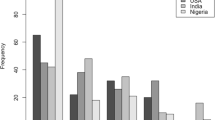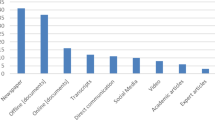Abstract
This article applies some ofthe insights from framing studies in policyresearch, metaphor analysis, and the history ofmedicine to a cultural understanding ofagriculture, using the 2001 outbreak of footand mouth disease in the UK as a case study.The article will show how metaphors of war wereused as a “rhetorical frame” by the media andas an implicit “action frame” by policy makers.It will be argued that although the war framemight initially have been useful in rallyingsupport for the slaughter policy, the metaphorlater backfired, when a metaphorical war turnedinto a literal holocaust. This might haveencouraged the public to perceive the policy asmedieval, brutal, and misguided, thuspotentially undermining the willingness ofsections of the public to support the slaughterpolicy in future outbreaks. If, on the otherhand, a vaccination policy were adopted in thefuture, care would need to be taken to avoidmetaphorical linkages with other controversiesover vaccination in other domains.
Similar content being viewed by others
References
A Crisis too Far (2001). A social and cultural record of the foot-and-mouth epidemic and its impact on the farming and rural community in the United Kingdom. Retrieved from http://www.footandmouthdoc.com/ on 15 January 2003.
Alexander, J. C. (ed.) (1988). Durkheimian Sociology: Cultural Studies. Cambridge, UK: Cambridge University Press.
Blake, A., M. T. Sinclair, and G. Sugiyarto (2002) Quantifying the impact of Foot and Mouth Disease on tourism and the UK economy. Nottingham University, Business School. Retrieved from http://www.nottingham.ac.uk/ttri on 15 January 2003.
Breakwell, G. (2002). Report to DEFRA (Department of the Environment, Farming and Rural Affairs): Public Perceptions Concerning Animal Vaccination: A Case Study of Foot and Mouth Disease. MS.
The BSE Inquiry (2000). The report. Retrieved from http:// www.bseinquiry.gov.uk/report/ on February 2003.
Carson, R. (1962). Silent Spring. Boston: Houghton Mifflin.
Conrad, P. (1997). “Public eyes and private genes: Historical frames, news constructions, and social problems.” Social Problems 44(2): 139-154.
Dunwoody, S. (1992). “The media and public perceptions of risk: How journalists frame risk stories.” In D. W. Bromley and K. Segerson (eds.), The Social Response to Environmental Risk (pp. 75-100). Boston: Kluwer Academic Publishers.
Durkheim, E. (1912). Les Formes élémentaires de la vie religieuse, le système totémique en Australie. Paris: PUF, 1990.
topic/ December02/fmd_final_report/ep_temp_comm_fmd_rep.htm on 15 January 2003.
Garfinkel, H. (1967). Studies in Ethnomethodology. Englewood Cliffs, New Jersey: Prentice Hall.
Gergen, K. J. (1997). Narrative, moral identity and historical consciousness: A social constructionist account. Retrieved from http://www.swarthmore.edu/SocSci/kgergen1/web/ page.phtml?id=manu3&st=manuscripts&hf=1 on September 2003. [Draft copy appearing as “Erzählung, moralische Identät und historisches Bewusstsein. Eine sozialkonstruktionistische Darstellung.” In J. Straub (ed.) (1998), Identität und historisches Bewusstsein. Frankfurt: Suhrkamp.]
Goffman, E. (1974). Frame Analysis: An Essay on the Organization of Experience. New York: Harper and Row.
GU = Guardian unlimited Archive (2001). Foot and mouth disease. Retrieved from http://www.guardian.co.uk/footand mouth/ on 15 January 2003.
Gwyn, R. (2001). Communicating Health and Illness. London: Sage.
Harvey, G. (1998). The Killing of the Countryside. London: Vintage.
Hargreaves, N. and G. Ferguson (2000). Who is misunderstanding whom? Bridging the gulf of understanding between the public, the media and science. Economic and Social Research Council. Retrieved from http://www.esrc.ac.uk/ whom/whofirst.html on 15 January 2003.
Husserl, E. (1913). Ideen zu einer reinen Phänomenologie und phänomenologischen Philosophie. [Ideas Pertaining to a Pure Phenomenology and to Phenomenological Philosophy, First Book, trans. F. Kersten.] The Hague: Nijhoff, 1982.
King, David (2001). The use of vaccination in the current FMD outbreak. Retrieved from http://www.defra.gov.uk/footand mouth/vaccination/kingarticle.htm on 15 January 2003.
Labov, W. (1981). “Speech actions and reactions in personal narrative.” In D. Tanner, (ed.), Analyzing Discourse: Text and Talk (pp. 219-247). Washington, DC: Georgetown University Press.
Lakoff, G. and M. Johnson (1980). Metaphors We Live By. Chicago, Illinois: Chicago University Press.
Lakoff, George (1992). The metaphor system used to justify war in the gulf. Retrieved from http://www.philosophy.uoregon.edu/metaphor/lakoff-l.htm on 15 January 2003.
MacLachlan, G. and I. Reid (1994). Framing and Interpretation. Melbourne: Melbourne University Press.
Mepham, Ben (2001). “Foot and mouth disease and British agriculture: Ethics in a crisis.” Journal of Agricultural and Environmental Ethics 14: 339-347.
Morpurgo, M. (2001). Out of the Ashes. London: Macmillan Children's Books.
Nelkin, D. (2001). “Molecular metaphors: The gene in popular discourse.” Nature Reviews/Genetics 2 (July 2002): 555-559.
Nerlich, B., D. D. Clarke, and R. Dingwall (1999). “The influence of popular cultural imagery on public attitudes towards cloning.” Sociological Research Online 4(3). Retrieved from http://www.socresonline.org.uk/socresonline/4/3/Nerlich.html on 15 January 2003.
Nerlich, B., C. Hamilton, and V. Rowe (2002). “Conceptualising foot and mouth disease: The socio-cultural role of metaphors, frames and narratives,” in metaphorik.de. Retrieved from http://www.metaphorik.de/02/nerlich.htm on 15 January 2003.
Nerlich, B. (2003). “Tracking the fate of the metaphor silent spring in British environmental discourse: Towards an evolutionary ecology of metaphor.” Special issue of metaphorik.de on Metaphor and Ecology, edited by Martin Döring und Wilhelm Trampe (http://www.metaphorik.de/04/nerlich.htm).
North, R. (2001). The Death of British Agriculture. London: Duckworth.
O'Hagan, A. (2001). The End of British Farming. London: Profile Books.
Poortinga, W., K. Bickerstaff, I. Langford, J. Niewöhner, and N. Pidgeon (2003). “The British 2001 foot and mouth Crisis: A comparative study of public risk perceptions, trust and beliefs about government policy in two communities.” Journal of Risk Research 6: 1-18.
Propp, V. (1968). Morphology of the Folktale. Austin: University of Texas Press.
Rosenberg, C. E. and J. Golden (eds.) (1992). Framing Disease: Studies in Cultural History. New Brunswick, New Jersey: Rutgers University Press.
Rosenberg, C. E. (1992). Explaining Epidemics and Other Studies in the History of Medicine. Cambridge, UK: Cambridge University Press.
Royal Society Report (2002). Infectious Diseases in Livestock The Royal Society Inquiry into Infectious Diseases in Livestock, chaired by Sir Brian Follett FRS. Retrieved from http://www.royalsoc.ac.uk/inquiry/index.html on 15 January 2003.
Schön, D. (1979). “Generative metaphor: A perspective on problem-setting in social policy.” In A. Ortony (ed.), Metaphor and Thought (pp. 254-283). Cambridge, UK: Cambridge University Press.
Schön, D. and M. Rein (1994). Frame Reflection. Toward the Resolution of Intractable Policy Controversies. New York: Basic Books.
Schutz, A. 1962. Collected Papers I: The Problem of Social Reality. Edited by Maurice Natanson. The Hague: Martinus Nijhoff.
Seale, C. (2001). “Sporting cancer: Struggle language in news reports of people with cancer.” Sociology of Health and Illness 23(3): 308-329.
Smith, P. (1991). “Codes and conflict; toward a theory of war as ritual.” Theory and Society 20(1): 103-138.
Sontag, S. (1979). Illness as Metaphor. London: Allen Lane.
Sontag, S. (1989). Aids and Its Metaphors. New York: Farrar, Straus, and Giroux.
Tannen, D. (1993). Framing in Discourse. Oxford: Oxford University Press.
Winter, M. (2003). “Responding to the crisis: The policy impact of the foot and mouth epidemic.” Political Quarterly 74(1): 47-57.
Woods, A. (2001). “Foot-and-mouth disease.” In M. Sissons (ed.), The Future of Rural Britain (pp. 99-124). London: Vintage.
Woods, A. (2002). Foot and Mouth Disease in 20th Century Britain: Science, Policy and the Veterinary Profession. Thesis, University of Manchester, UK.
Author information
Authors and Affiliations
Corresponding author
Rights and permissions
About this article
Cite this article
Nerlich, B. War on foot and mouth disease in the UK, 2001: Towards a cultural understanding of agriculture. Agriculture and Human Values 21, 15–25 (2004). https://doi.org/10.1023/B:AHUM.0000014022.42425.a9
Issue Date:
DOI: https://doi.org/10.1023/B:AHUM.0000014022.42425.a9




